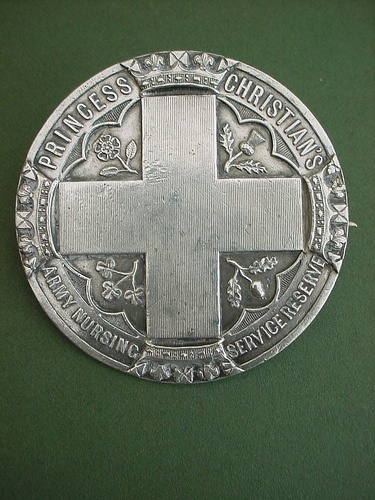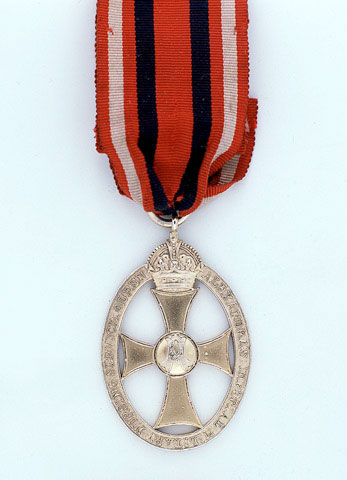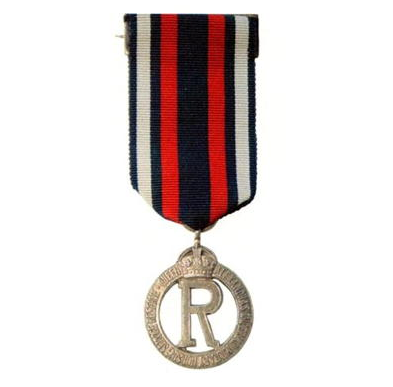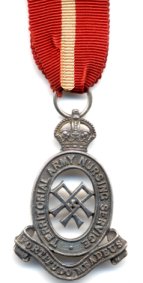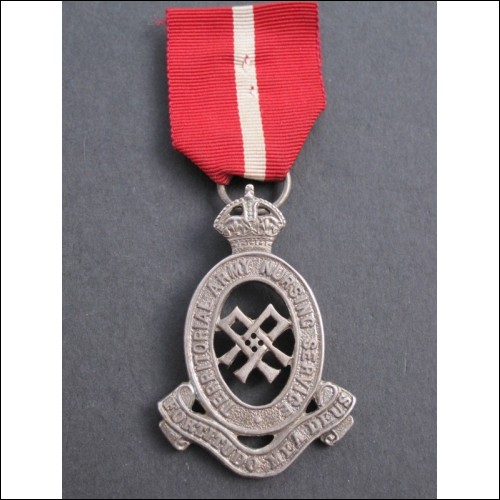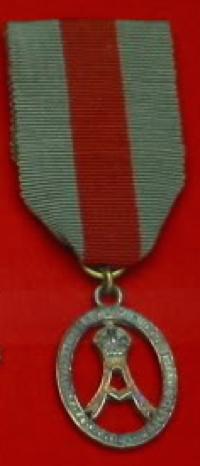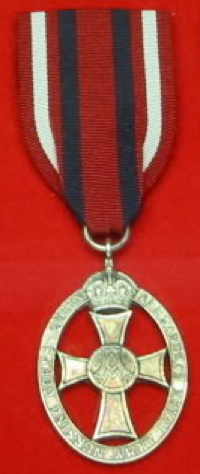Tippet Medals: Difference between revisions
No edit summary |
No edit summary |
||
| Line 21: | Line 21: | ||
! Tippet Badge !! Text | ! Tippet Badge !! Text | ||
|- | |- | ||
| ||<b>Princess Christian's Army Nursing Service (Reserve)</b> | |[[File:Pcansr.jpg]] ||<b>Princess Christian's Army Nursing Service (Reserve)</b> | ||
* 1897 until final disbandment in 1907. | * 1897 until final disbandment in 1907. | ||
* No records held at TNA apart from medal rolls for Boer War. | * No records held at TNA apart from medal rolls for Boer War. | ||
* Some transferred in 1902 to the new QAIMNS.]] | * Some transferred in 1902 to the new QAIMNS.]] | ||
|- | |- | ||
| ||<b>Queen Alexandra's Imperial Military Nursing Service</b> | |[[File:Qaimns.jpg]] ||<b>Queen Alexandra's Imperial Military Nursing Service</b> | ||
* 1902 – 1949. | * 1902 – 1949. | ||
* Records held at TNA, weeded in 1920s and 1930s. | * Records held at TNA, weeded in 1920s and 1930s. | ||
|- | |- | ||
| ||<b>Queen Alexandra's Imperial Military Nursing Service (Reserve)</b> | |[[File:Qaimnsr.png]] ||<b>Queen Alexandra's Imperial Military Nursing Service (Reserve)</b> | ||
* 1908 – 1949. | * 1908 – 1949. | ||
* Records held at TNA, weeded in 1920s and 1930s. | * Records held at TNA, weeded in 1920s and 1930s. | ||
* Members were transferred to the Regular Army Reserve of Officers (RARO) in 1950.<b> | * Members were transferred to the Regular Army Reserve of Officers (RARO) in 1950.<b> | ||
|- | |- | ||
| ||<b>Territorial Force Nursing Service</b> | |[[File:TFNS-capemedal.jpg| center]] ||<b>Territorial Force Nursing Service</b> | ||
* 1908 – 1921. | * 1908 – 1921. | ||
* Records held at TNA, weeded in 1920s and 1930s. | * Records held at TNA, weeded in 1920s and 1930s. | ||
|- | |- | ||
| | | [[File:Tans.jpg]] ||<b>Territorial Army Nursing Service</b> | ||
* 1921 – 1949. | * 1921 – 1949. | ||
* Members became QARANC Territorial Army in 1949. | * Members became QARANC Territorial Army in 1949. | ||
|- | |- | ||
| ||<b>Queen Alexandra's Military Families Nursing Service</b> | |[[File:QAFMNS.png|center]] ||<b>Queen Alexandra's Military Families Nursing Service</b> | ||
* 1921 – 1926. | * 1921 – 1926. | ||
* Designated to nurse families of British soldiers. | * Designated to nurse families of British soldiers. | ||
* Amalgamated with QAIMNS. | * Amalgamated with QAIMNS. | ||
|- | |- | ||
| ||<b>Queen Alexandra's Royal Army Nursing Corps</b> | |[[File:QARANC.png|center]] ||<b>Queen Alexandra's Royal Army Nursing Corps</b> | ||
* 1949 became a formally constituted Corps of the British Army and continues. | * 1949 became a formally constituted Corps of the British Army and continues. | ||
* Men admitted 1992. | * Men admitted 1992. | ||
|- | |- | ||
|} | |} | ||
Latest revision as of 10:44, 5 October 2024
Context
Although we call them tippet ‘medals’ they are really tippet ‘badges’ as they were issued with the uniform and returned when leaving the service (although some nurses were able to retain them, following a long period of service).
We have not yet found a definitive archive account of how or why they were introduced. Looking at the first badges and when they were introduced, there are some strong clues to their origin.
The first tippet badges as we know them were introduced in 1902 at the time of the formation of the Queen Alexandra’s Imperial Military Nursing Service (QAIMNS). Although there had been Army nurses in uniform since 1881, previously they had been an adjunct to the Army rather than part of it. The nurses in the earlier Army Nursing Service did not wear any badges though the Princess Christian Army Nursing Service (Reserve) did have a round silver badge worn on the tippet.
The QAIMNS was formed as part of the Army with a Matron-in-Chief to oversee the service. Now nurses were recognised as part of the Army they were entitled to the same recognition as other regiments, corps and services.
Other regiments and corps were able to identify themselves to others by the insignia they wore. They had cap badges, buttons, shoulder badges and stable belts, for example. When we look at the uniforms that Army nurses wore in 1902 it is clear that it was not possible to wear any insignia in the way that soldiers did.
The solution was clearly the tippet badge which was the equivalent of a cap badge hanging on a ribbon in the form of a ‘medal’. The ribbon was the scarlet, blue and white colours now seen on the Corps flag, Corps stable belts and the Corps Tactical Recognition Flash. The tippet badges have always been made in silver, with the exception of a few (and now rare) bronze badges issued to men attached to the QAIMNS.
Following the original badge for the QAIMNS further designs were created for the QAIMNS Reserve, the Territorial Force Nursing Service, The Queen Alexandra’s Imperial Military Families Nursing Service, the Territorial Army Nursing Service, and the Queen Alexandra’s Royal Army Nursing Corps.
As uniforms changed, and nurses were able to wear cap badges and other insignia, the tippet badge was retained for when nurses were in their ward uniform. The tippet badge is no longer issued or worn on uniform.
